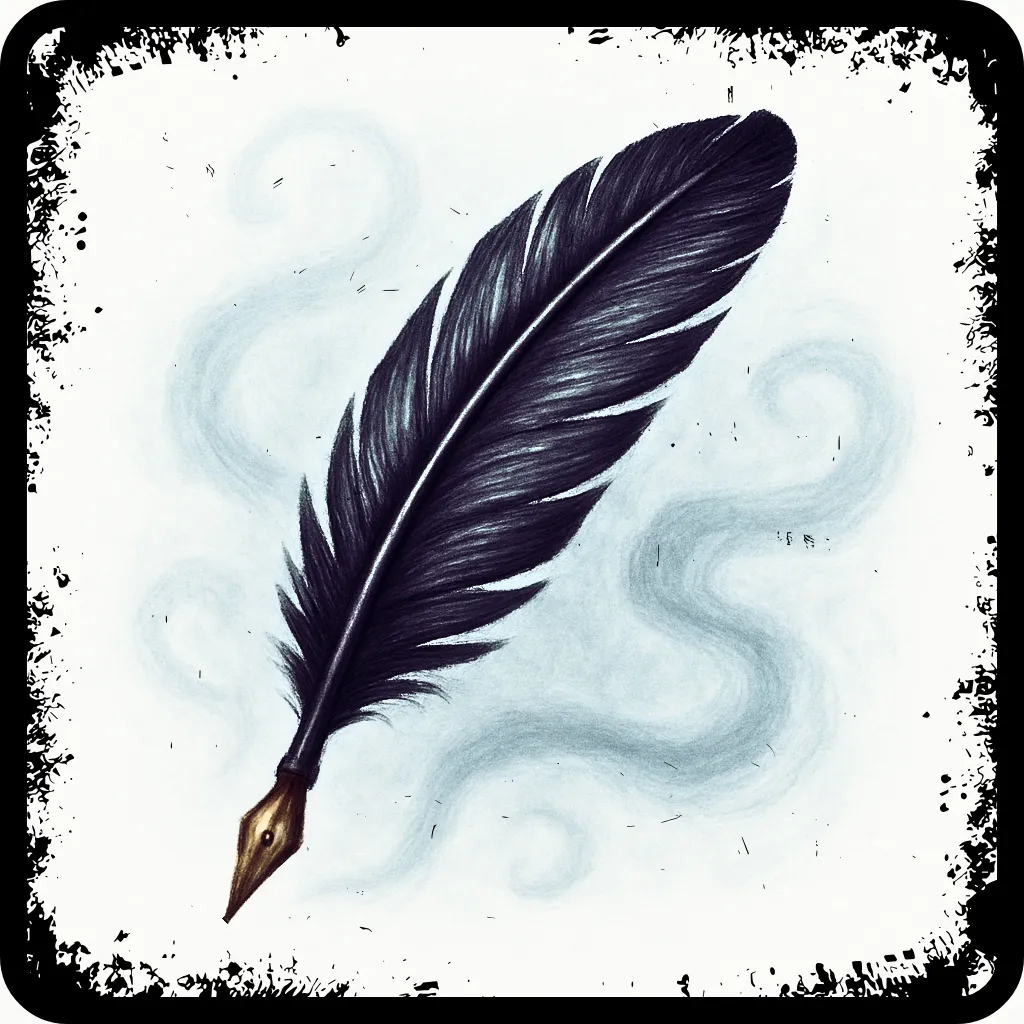Arcana Vault
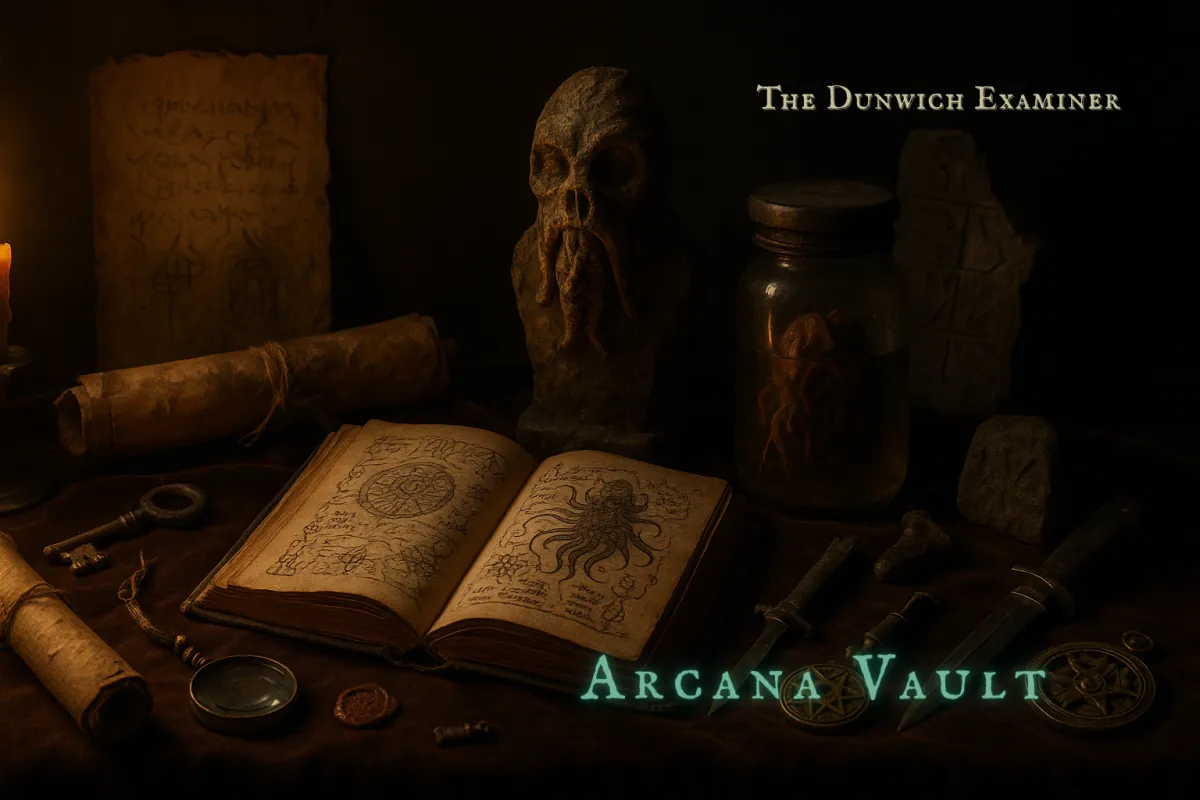
Arcana of the Known and the Half-Known
These chronicles are haunted not only by events, but by those who shaped them—individuals, entities, and objects that etched themselves into the unfolding mystery. Some walked beside Crowe in breath and shadow. Others emerged only through blood, resonance, or whisper.
The full curated Arcana is preserved separately for those who seek deeper clarity—or greater disquiet. Proceed with discernment. Some truths do not linger idly when observed.
While their authenticity remains difficult to verify in certain cases, each artifact contributes to a broader understanding of the phenomena surrounding Nathaniel Crowe’s investigations. Here we present an ever-expanding archive of character dossiers, classifications of encountered beings, and examinations of unearthed artifacts. Readers are advised to interpret these materials with appropriate caution.
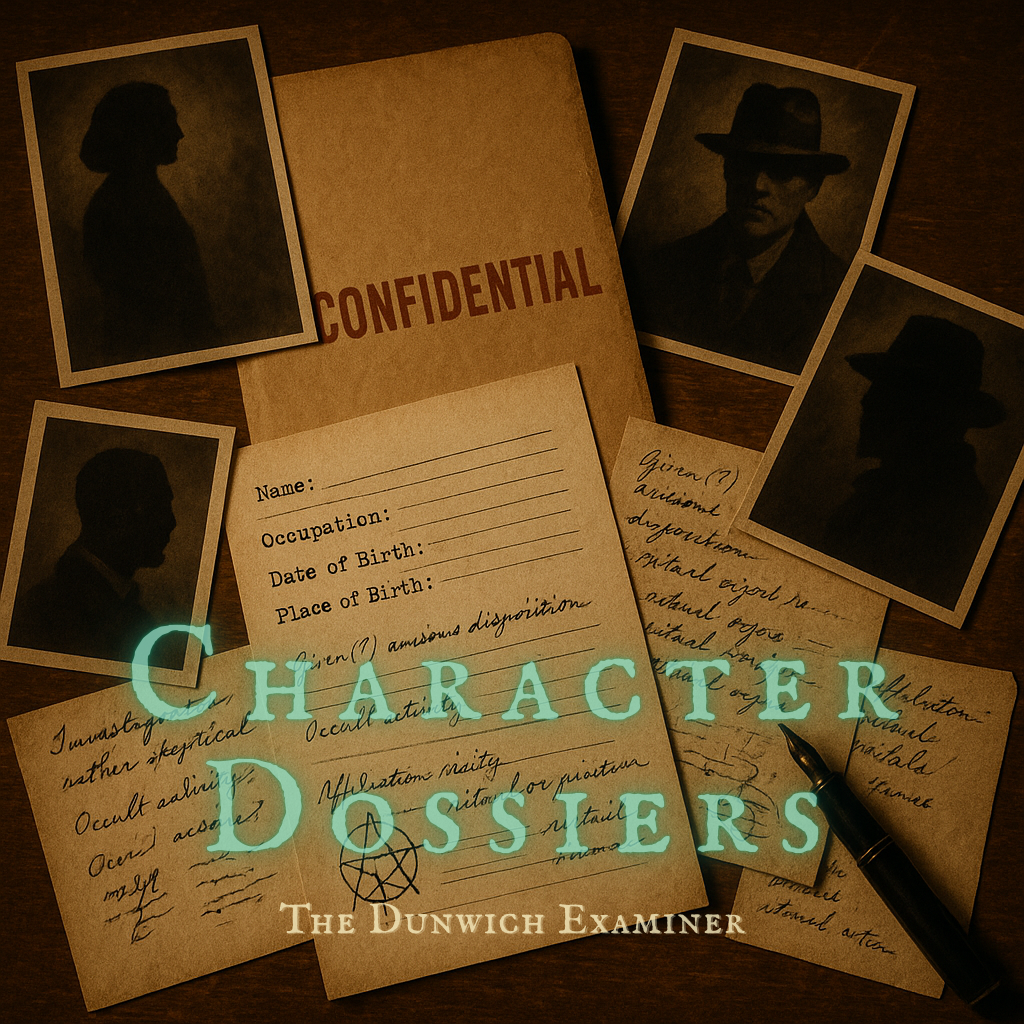
These assembled records preserve the known histories of those whose lives have intersected with the hidden investigations chronicled by The Arkham Examiner. Compiled from eyewitness statements, intercepted correspondence, and fragments of personal journals, each file attempts to capture the truth—or as much of it as can be verified—about these singular individuals.
Some emerge as trusted companions and stalwart allies, lending their knowledge, skills, and resolve to the perilous work of confronting the unknown. Others stand in shadow, their intentions obscured, their loyalties shifting like the fog off the Miskatonic. Between the two lie those whose actions defy easy judgment, whose roles in unfolding events remain uncertain.
Every dossier contains more than dates and descriptions—it holds the threads of origin, the marks of allegiance, and the hidden motives that shape the course of these investigations. Read them with caution, for even the most complete file may conceal as much as it reveals.

These assembled records preserve the known histories of those whose lives have intersected with the hidden investigations chronicled by The Dunwich Examiner. Compiled from eyewitness statements, intercepted correspondence, and fragments of personal journals, each file attempts to capture the truth—or as much of it as can be verified—about these singular individuals.
Some emerge as trusted companions and stalwart allies, lending their knowledge, skills, and resolve to the perilous work of confronting the unknown. Others stand in shadow, their intentions obscured, their loyalties shifting like the fog off the Miskatonic. Between the two lie those whose actions defy easy judgment, whose roles in unfolding events remain uncertain.
Every dossier contains more than dates and descriptions—it holds the threads of origin, the marks of allegiance, and the hidden motives that shape the course of these investigations. Read them with caution, for even the most complete file may conceal as much as it reveals.
Emory Holt

The following excerpt was taken from the personal notes of Emory Holt, recovered shortly after the arrival of the Crowe journals. As chief archivist of The Arkham Examiner, Holt’s role was to catalog, annotate, and verify the authenticity of the materials now collected into this volume.
A discreet figure in the city of Arkham, Emory Holt is known only to a small circle of colleagues, researchers, and surviving witnesses. He serves as the Examiner’s last line of review—its filter and its firebreak. Nothing reaches publication without passing through his hands. Fewer still ever see the light of day. His office, buried two levels beneath Belknap Street, has no windows and no nameplate. The air is always cold. The bulbs flicker. Holt works mostly by lamplight and refuses to discard any material, no matter how damaged or disturbing. To those who’ve met him, he is precise, dry-witted, and strangely sympathetic. But he does not shake hands. He rarely blinks. He does not sleep.
For over a decade, Emory Holt has curated the Examiner’s forbidden archive—an underground collection of unpublished field reports, anonymous testimonies, recovered journal fragments, and photographic anomalies, many of which were dismissed as hoaxes or suppressed at the behest of unknown parties. It was Holt who reconstructed the Whitcroft Dossier, decrypted the Mallory Tapes, and identified the true cause of the Kingsport Lighthouse blackout in 1922. He is not a writer. He is not a journalist. He is a custodian of haunted things.
When the journals of Nathaniel Crowe arrived—burnt, bloodstained, and incomplete—it was Emory Holt who took up the task of restoration. He sorted fragments by date and tone. He transcribed damaged tapes by ear, often looping the same five-second stretches for hours. He tracked down references to long-demolished tenements and mapped correlations between local disappearances and obscure symbols found etched in basement walls. What you now hold in your hands is the result of that tireless, obsessive work.
Holt has stated, in notes recovered alongside the Crowe collection, that the material left him deeply unsettled. He describes auditory hallucinations while transcribing. He notes the sudden failure of multiple electric lamps. He references one journal entry that “rewrites itself” when left unread for too long. These claims are preserved here without endorsement, but the consistency with which they appear—across ink, tape, and typewritten page—warrants inclusion.
The chronicles are not narrative embellishments. They are records of a man’s attempt to document the hidden order of a world we are not meant to see. The work of Nathaniel Crowe would likely have vanished without Holt’s intervention. Thanks to him, the pieces have been gathered. The story, insofar as it can be told, has been arranged. But no answers are given. Only patterns. Only echoes.
A Word to the Curious
If you are reading this, you have already begun to peer beneath the veil. Perhaps you’ve heard the rumors—of the things seen in the waters off Kingsport, of the whispers echoing in the tunnel systems below Arkham, of the fire on Whitcroft Street that left no bodies but a single scorched journal.
This archive is not a work of entertainment. It is a record. It is testimony. Read it as such. And take care. Some truths, once known, do not return quietly to the dark.
Nathaniel Crowe
Profession
Occult Investigator, Scholar of Forgotten Truths, and Chronicler of the Unnameable
Affiliation
Formerly Miskatonic University, now independent; operating from a discreet office above a shuttered haberdashery on West Pickman Street, Arkham
Location
Arkham, Massachusetts – a second-floor walk-up office, lit by gas lamp and memory, papered in cryptic maps and ritual diagrams
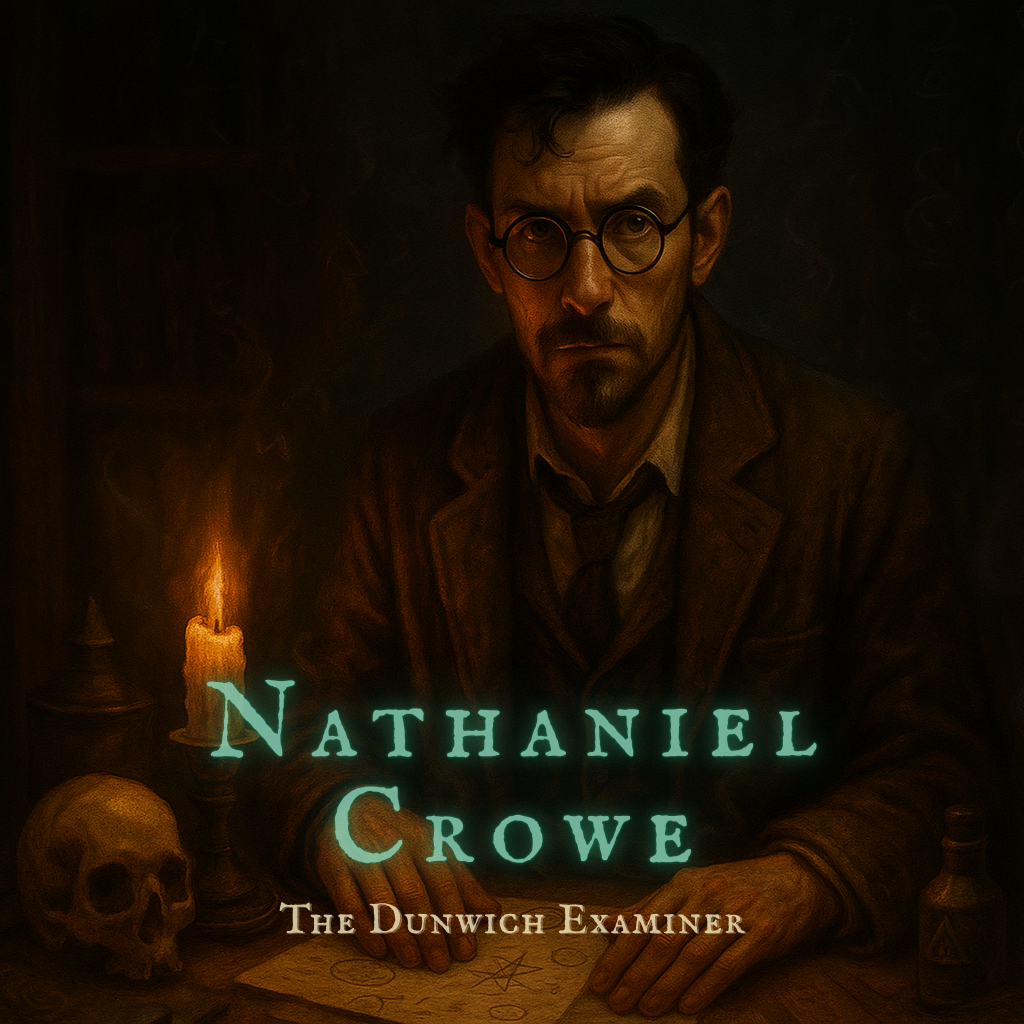
Profession
Occult Investigator, Scholar of Forgotten Truths, and Chronicler of the Unnameable
Affiliation
Formerly Miskatonic University, now independent; operating from a discreet office above a shuttered haberdashery on West Pickman Street, Arkham
Location
Arkham, Massachusetts – a second-floor walk-up office, lit by gas lamp and memory, papered in cryptic maps and ritual diagrams
Origins
Nathaniel Crowe was born in the autumn of 1887 beneath a blood-orange harvest moon—a birth many of Arkham’s elder matrons regarded as a sign best left unmentioned. He was the only child of Thaddeus Crowe, a stern antiquarian whose personal library rivaled those of small colleges, and Lilith Crowe, a gifted pianist whose compositions, some whispered, left room for a second melody only the haunted could hear.
Their home, a crumbling Federalist mansion perched on the bank of the Miskatonic, was as much mausoleum as residence. Nathaniel grew up surrounded by dust-choked tomes, shadowy corners, and a silence that seemed curated. When he was nine, his mother vanished without trace. No body was found. No search was mounted. Her name became an absence—echoed in the strange chords she left behind and the locked room Thaddeus refused to enter again.
This early trauma instilled in Nathaniel a forensic obsession with the unseen. He devoured ancient texts before adolescence and was admitted to Miskatonic University at sixteen. There, he studied linguistics, comparative religion, and folkloric epistemologies, quickly earning a reputation for brilliance tainted by unease. His ability to read dead languages came with uncanny fluency. He once identified a dialect as a precursor to the pre-Akkadian tongue before a formal record of its existence had been published.
He was poised for a tenured future until the Dunwich incident.
During an unauthorized excavation of a cairn site northwest of Dunwich, Crowe and four university colleagues encountered something buried too long and remembered too well. Three were found dead. One survived, but would never speak again. Nathaniel was discovered thirty hours later, half-buried in peat moss and muttering a language unknown even to the most senior philologists. His hands were stained with ochre. His memory—mostly erased.
Miskatonic quietly severed ties. The official report was sealed.
Role in the World of the Dunwich Examiner
Crowe left academia and reemerged as something else—something Arkham has no title for. A private investigator, yes, but not of crimes. His purview lies at the ragged edge where reason fails: unnatural disappearances, haunted properties, occult inscriptions, temporal anomalies, and dreams that arrive from places without maps.
Operating in shadows, he became an unlisted fixture among Arkham’s desperate and its well-connected alike. Probate attorneys, curators, widows, and priests have all sought his assistance when faced with the inexplicable. His methods blend scholarly precision with ritual intuition. His toolkit includes phonograph cylinders, dowsing rods, obscure grimoires, and a weathered leather journal that he refuses to let out of his sight.
Crowe documents each case for The Dunwich Examiner—not the daily paper, but a secretive ledger of eldritch events that he alone updates. Whether the “Examiner” truly circulates is unknown.
Despite his intellect, Crowe is deeply isolated. Few know him well. Fewer still see him twice.
Character Traits
Methodical and reserved – Every word is chosen. Every pause has weight.
Scarred but skeptical – Believes in truth, not mysticism—yet encounters both.
Ritualistic behaviors – Begins each morning by lighting a candle and reciting a Latin phrase from his mother’s notebook.
Sleepless – Sleeps rarely, and only with salt in the corners of the room.
Unseen connections – Possesses an uncanny sense of synchronicity—objects seem to find him when needed, as if following an invisible logic.
Arthur Pendell
Profession
Occult Investigator, Scholar of Forgotten Truths, and Chronicler of the Unnameable
Affiliation
Founding Partner, Pendell & Thorne, Attorneys at Law, Arkham
Location
Offices on the second floor of a converted 18th-century apothecary at 5 Curwen Street, Arkham
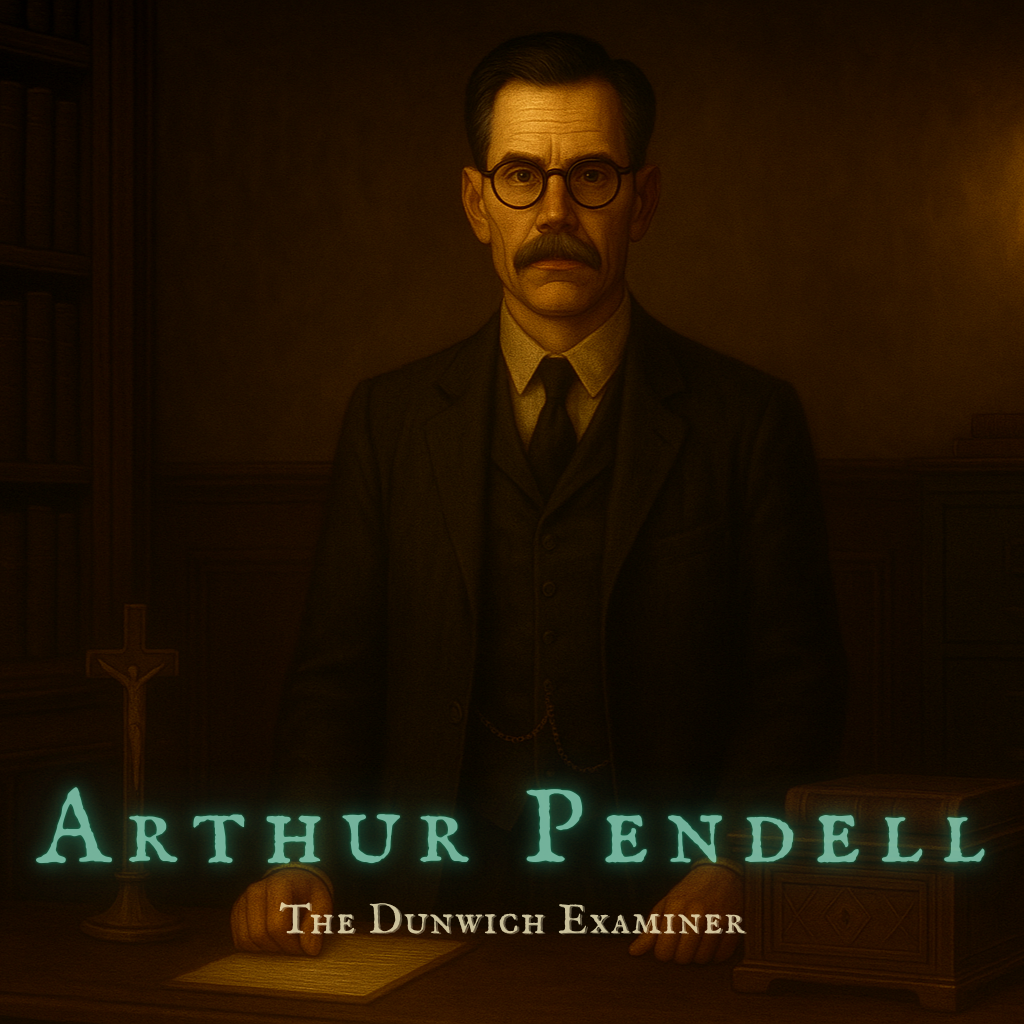
Profession
Occult Investigator, Scholar of Forgotten Truths, and Chronicler of the Unnameable
Affiliation
Founding Partner, Pendell & Thorne, Attorneys at Law, Arkham
Location
Offices on the second floor of a converted 18th-century apothecary at 5 Curwen Street, Arkham
Backstory
Arthur Pendell has made a quiet living handling the estates that no one else will touch—where heirs hesitate to claim, basements are bolted with lead seals, and wills contain stipulations written in blood rather than ink. A native of Arkham, he was once known simply as a capable and conservative attorney with a fondness for Cicero and an intolerance for legal ambiguity. That was before the Whitcroft Street house—before Sanctum Null.
Pendell first crossed paths with Nathaniel Crowe while representing the Mallory family in a seemingly routine posthumous estate reassignment. The case required unlocking a sealed sublevel beneath the Old Hill property. What was meant to be a formal inspection turned into something else entirely—an encounter that left one laborer dead, a contractor institutionalized, and Pendell unable to explain what he saw without inviting disbarment or worse.
That was when he began dimming the lights.
Since then, Pendell has become the unspoken legal stopgap between Arkham’s haunted past and the present that wants to forget it. He drafts legal instruments for properties with shifting architecture. He arranges ownership transfers for dwellings shunned by churches. And when no legitimate clause can cover what’s occurred, he calls Nathaniel Crowe.
Though Pendell presents a composed exterior—classical suits, neat mustache, always a pocket watch—there’s an exhaustion behind his eyes that no amount of logic can soothe. He now codes his most volatile case files in Latin, stores certain documents in fireproof cabinets submerged in brine, and keeps a consecrated bell on his office door—just in case.
He doesn’t believe in the supernatural. He’s simply witnessed its paperwork.
Role in the World of the Dunwich Examiner
Pendell is Crowe’s point of entry into many investigations—not through mystical signs or whispered lore, but through deeds, probates, and municipal archives that hint at what polite society pretends isn’t there. If Crowe is the hand that reaches into the void, Pendell is the one who notarizes the damage afterward.
Their dynamic is marked by reluctant necessity. Pendell resents how often Crowe’s presence presages chaos, yet he is one of the few who never doubts the need for him. Crowe, in turn, relies on Pendell’s discretion and dogged rationality, knowing that even the impossible still casts legal shadows.
Character Traits
Quietly paranoid. Never sits with his back to the window.
Loyal but strained. Won’t abandon Crowe, but wishes he could forget him.
Intellectually orthodox. Still quotes Blackstone and insists on proper documentation, even when documenting impossible things.
Superstitiously practical. Keeps a crucifix in one drawer, an elder sign in the other. Believes in backups.
Stubbornly composed. Voice rarely raises, even when the walls begin to breathe
Camilla Brant
Profession
Occult Investigator
Affiliation
Formerly of Arkham
Location
Innsmouth
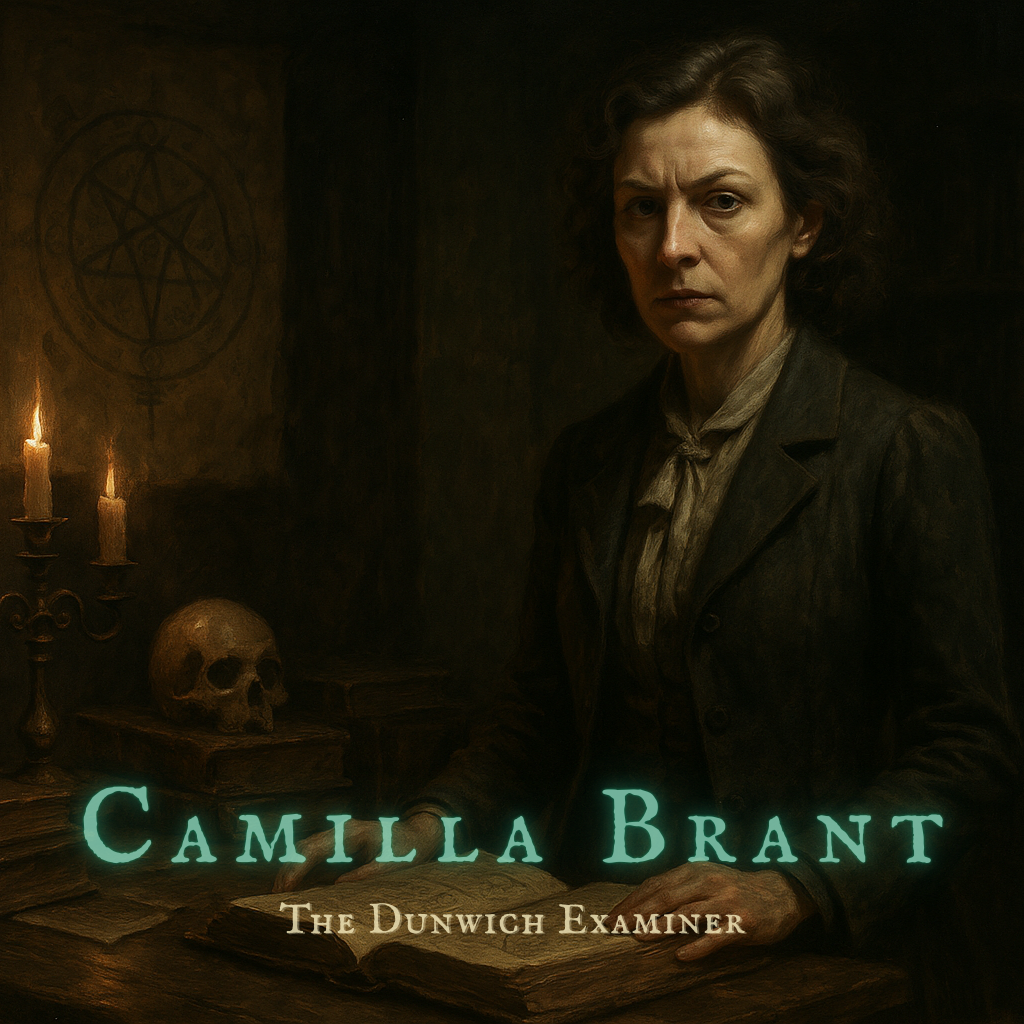
Profession
Occult Investigator
Affiliation
Formerly of Arkham
Location
Innsmouth
Backstory
Camilla Brant was born to a salt-weathered estate on the outskirts of Arkham, where the Miskatonic meets the sea. Her lineage is entangled in the arcane currents of New England’s occult past, echoing with unbidden rituals and broken covenants that still whisper through the tides. At twelve, her father vanished at sea under a cloudless sky. In his study, Camilla uncovered a hidden archive—maritime charts inked with unknowable symbols, barnacled folios of larval gods, and sermon fragments penned in hybrid tongues. Something had been pieced together, and something else—something sacred—unraveled.
Leaving behind the stifled halls of Miskatonic University, Camilla fled to Innsmouth under assumed identities, driven by the lure of aquatic liturgies and submerged litany. In the crumbling sanctuaries of the First Church of Dagon, she listened in darkness to the distorted sermons of the Esoteric Order. Her research turned inward and downward—toward glyphs etched in brine-soaked bone, toward artifacts that pulsed faintly beneath sea-glass and sediment.
Camilla came to believe that resonance itself—the harmonic alignment of symbol, voice, and blood—was the mechanism by which memory rewrote reality. Her studies turned to the Resonant Rite, a theory half-whispered in abandoned tomes and salted dreams. Each text brought her closer to something vast and submerged. And something in her blood responded.
She is no longer entirely of Arkham. But neither is she entirely of Innsmouth. She lives in the threshold.
Role in the World of the Dunwich Examiner
Camilla Brant serves as a volatile beacon in Crowe’s descent through the secrets of Innsmouth. It is her glyph-marked letters and sermon fragments that first draw Crowe toward the resurgence of the Esoteric Order. Her research unveils the Resonant Rite and the bloodline theory embedded in Deep One scripture.
Twice, her warnings prevent fatal missteps. Once, she guides him through the archives beneath the fire-gutted Innsmouth Library, and again she steadies the ritual breach in the Sea-Glassed Foundry. Their alliance is tense—anchored by mutual intellect and riddled with buried trust. She may be the one soul Crowe cannot determine to be guide or gatekeeper.
Character Traits
Voice low and laced with unease
Scornful of academic proprieties
Wears a triangle of abalone on a red thread
Jealously guards unverified findings
Speaks fluent Latin, Akkadian, and two unnamed hybrid tongues
Appears dry even when soaked by tide
Sleeps facing north, as though listening for the sea
Delilah Snow
Profession
Spiritualist Medium and Dream Channel
Affiliation
Unaffiliated, formerly consulted for Miskatonic Occult Studies Circle
Location
Unknown, last seen departing Innsmouth by foot into coastal fog
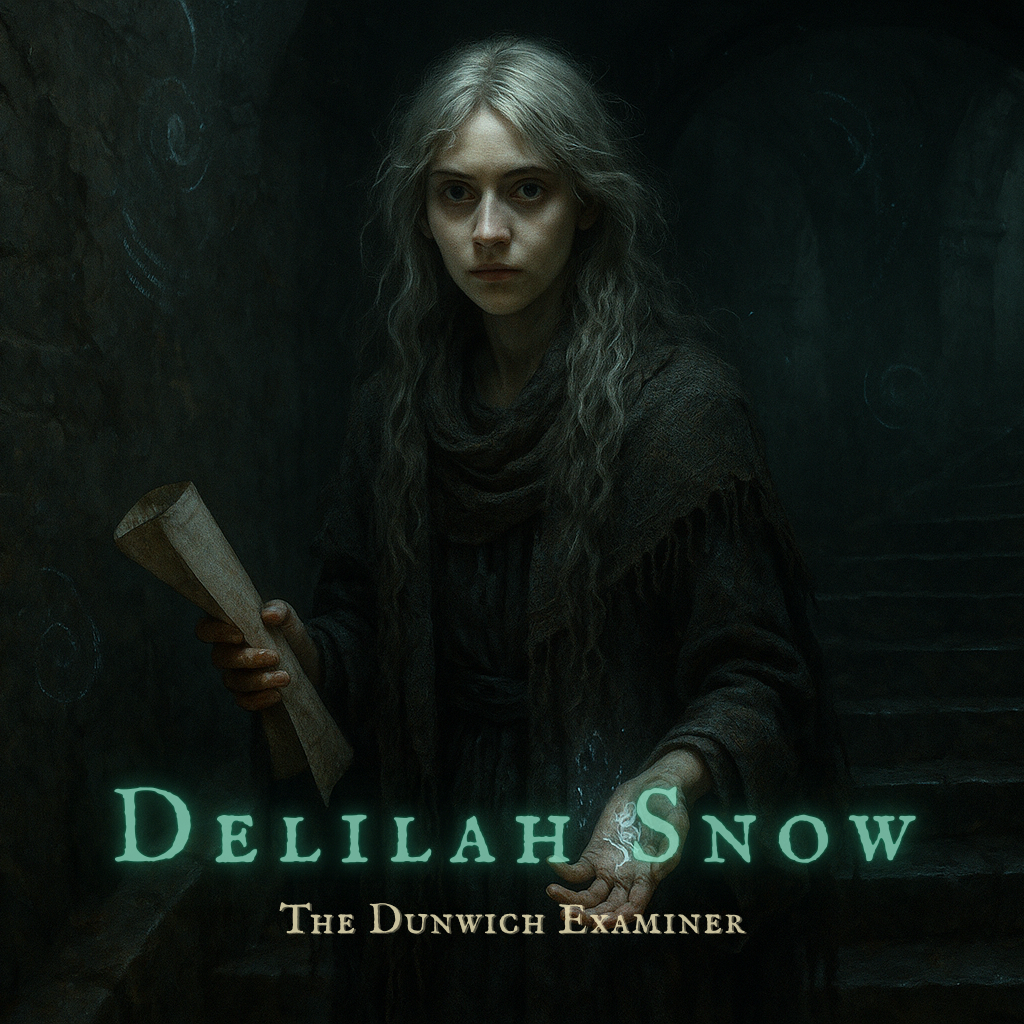
Profession
Spiritualist Medium and Dream Channel
Affiliation
Unaffiliated, formerly consulted for Miskatonic Occult Studies Circle
Location
Unknown, last seen departing Innsmouth by foot into coastal fog
Backstory
Delilah Snow was born in the attic room of a boarding house on the edge of Arkham’s Blackwood Cemetery. Her mother, a mute seamstress with blank eyes, vanished before Delilah was old enough to walk. Raised by an indifferent foster matron and the whispers that lived between the walls, Delilah displayed signs of trance-state receptivity before age six—scribbling glyphs on coal walls and naming people not yet dead.
Her talents were feared but tolerated. At fourteen, she was institutionalized for three months following a sleepwalking incident wherein she was found at the Old Hill mound with her feet submerged in fresh grave soil, humming a lullaby in no known tongue. Miskatonic University's Department of Rhetorical Alchemy briefly took an interest in her, collecting her journal pages as part of their “living semiotic resonance” experiment. She left Arkham shortly after an unnamed professor suffered a breakdown during one of her induced trance sessions.
For the next decade, Delilah drifted between sanctums, séances, and ruins, building a quiet reputation as a reluctant but effective medium. She avoided permanent affiliation, claiming that "roots attract worms." Her dreams were often more accurate than her waking insights. A month before the Innsmouth event, she began experiencing recurring visions of coral cathedrals, drowned songbooks, and glyphs that appeared in her breath-fog.
Role in the World of the Dunwich Examiner
Delilah entered Crowe’s orbit during the Mallory Estate case, her visions proving instrumental in identifying the breached seal in Room 9. But it was during the Esoteric Order crisis in Innsmouth that she became essential. Drawn by dream, she arrived without summons—bearing glyphs that matched those only Crowe had recorded. Her trance-speech helped decode the Resonant Rite, while her blood sacrifice disrupted its climax.
Their connection ran deeper than professional alliance. Delilah mirrored Crowe’s own descent—each of them dream-touched, drawn to glyph and tide, half-believers in what they already knew. Her presence grounded him, though it became increasingly clear that she too was changing: her eyes deepening, her pulse aligning with forgotten harmonies. By the ritual’s end, she carried within her the memory of something older than selfhood—and bore glyphs that pulsed with meaning still unfolding.
Character Traits
Speaks in her sleep, often in a prehuman dialect associated with the Deep Reef hymns
Keeps a bundle of vellum sketches of glyphs she cannot consciously recall drawing
Carries an antique locket that she never opens—it hums faintly when near brine
Has scars on her fingertips from tracing wards in salt across mirror surfaces
Suffers temporal dislocation during high trance—remembers conversations not yet spoken
Wears shawls soaked in valerian and dried kelp; claims it keeps "the louder dreams out"
Occasionally weeps brine when overwhelmed by memory-reverberant places
Dorian Tewksbury
Profession
Occult Field Cartographer and Excavation Assistant
Affiliation
Contracted to Nathaniel Crowe (Informal), formerly with the Kingsport Antiquarian Survey
Location
Arkham, presumed residing in a temporary boarding house on the north ridge
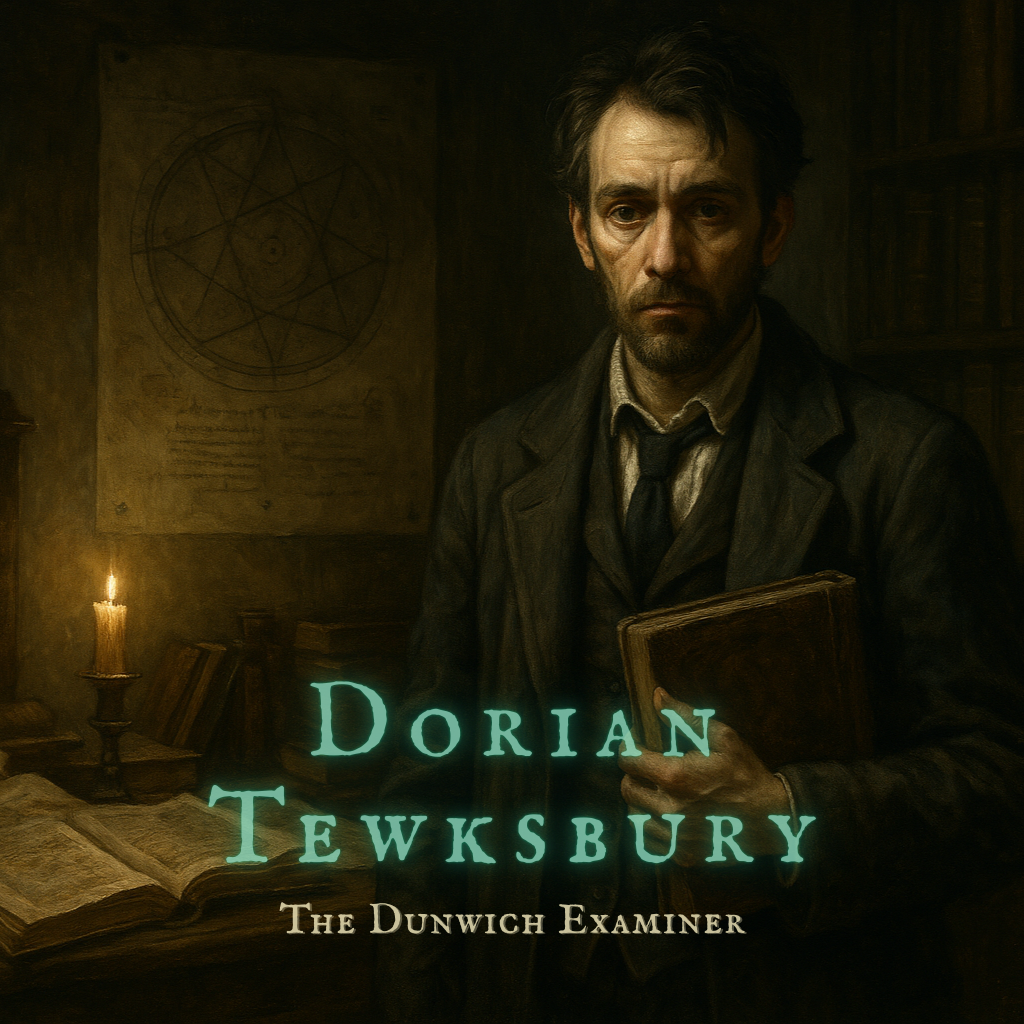
Profession
Occult Field Cartographer and Excavation Assistant
Affiliation
Contracted to Nathaniel Crowe (Informal), formerly with the Kingsport Antiquarian Survey
Location
Arkham, presumed residing in a temporary boarding house on the north ridge
Backstory
Dorian Tewksbury was born in the sea-shadowed port of Kingsport, son of a failed mapmaker and a woman who whispered to shore-bound winds. Raised among damp stacks of nautical charts and heirloom compasses that never pointed true, Dorian came of age believing that geography was not fixed, but argued with by time, memory, and dream. As a young man, he was dismissed from the Kingsport Antiquarian Survey for submitting a topographical analysis of the Anchor’s Point peninsula that included structures invisible to any other observer and paths that reversed when followed twice.
He fled to Arkham under shadowed recommendation, taking odd cartographic commissions and working nights as a record-keeper at the Orne Library. A fire in the east annex one winter evening destroyed half the genealogical maps stored in his care. Dorian insisted they’d restructured themselves into patterns of recursive ancestry before the flames ever touched them. He was quietly let go, but the incident brought him into brief correspondence with scholars like Silas Eberhart, who found his sketches troublingly prescient.
It was in this liminal drift that Dorian encountered Nathaniel Crowe—a man with no need for sanity, only precision. Hired for his ability to sense spacial divergence and catalog anomalies in impossible geometry, Dorian became a reluctant specialist in mapping things that ought not exist.
He rarely speaks of his dreams, save to say that some of the places he charts continue to expand behind his eyes, even when unobserved.
Role in the World of the Dunwich Examiner
Dorian’s meticulous, if nervous, assistance was instrumental in several of Crowe’s more physically treacherous investigations. During the Mallory Cellar Descent, it was Dorian who first identified the helical architecture that signaled recursive spatiality—a curvature that should have collapsed the cellar but instead unfolded it into greater depth. He also recorded the earliest known drawing of the sigil later termed the Glyph of Null, unknowingly transcribing it into his notes before encountering it in the field.
Crowe trusts Dorian’s observational instincts, if not always his nerve. Their dynamic is uneasy but functional—Crowe tolerates Dorian’s frayed demeanor and compulsive note-making, while Dorian is increasingly haunted by the realization that Crowe’s work is less about containment and more about chronicling the unraveling of reality.
By the end of The Shunned Cellar, Dorian is physically changed—drawn and pale, claiming to dream in topographies rather than symbols. He insists that the rooms beneath Mallory House continue to redraw themselves, and that something down there remembers him personally.
Character Traits
Carries hand-drawn, non-Euclidean maps stitched into a leather folio that occasionally shifts weight
Flinches at sudden silence more than noise; insists it means “something’s listening”
Chews willow bark to calm nerves, believing it dulls certain frequencies
Claims he can sense when doors are older on the inside than the outside
Wears an inherited compass that points toward “forgotten paths”
Keeps a candle stub from the Ward House in his pocket as a personal ward
Speaks in his sleep in a dialect resembling drowned Latin, which he does not understand when awake
Jonas Vellum
Profession
Antiquarian and Archaic Textual Scholar
Affiliation
Unaffiliated; Formerly of the Kingsport Historical Society
Location
Upper Mews District, Kingsport
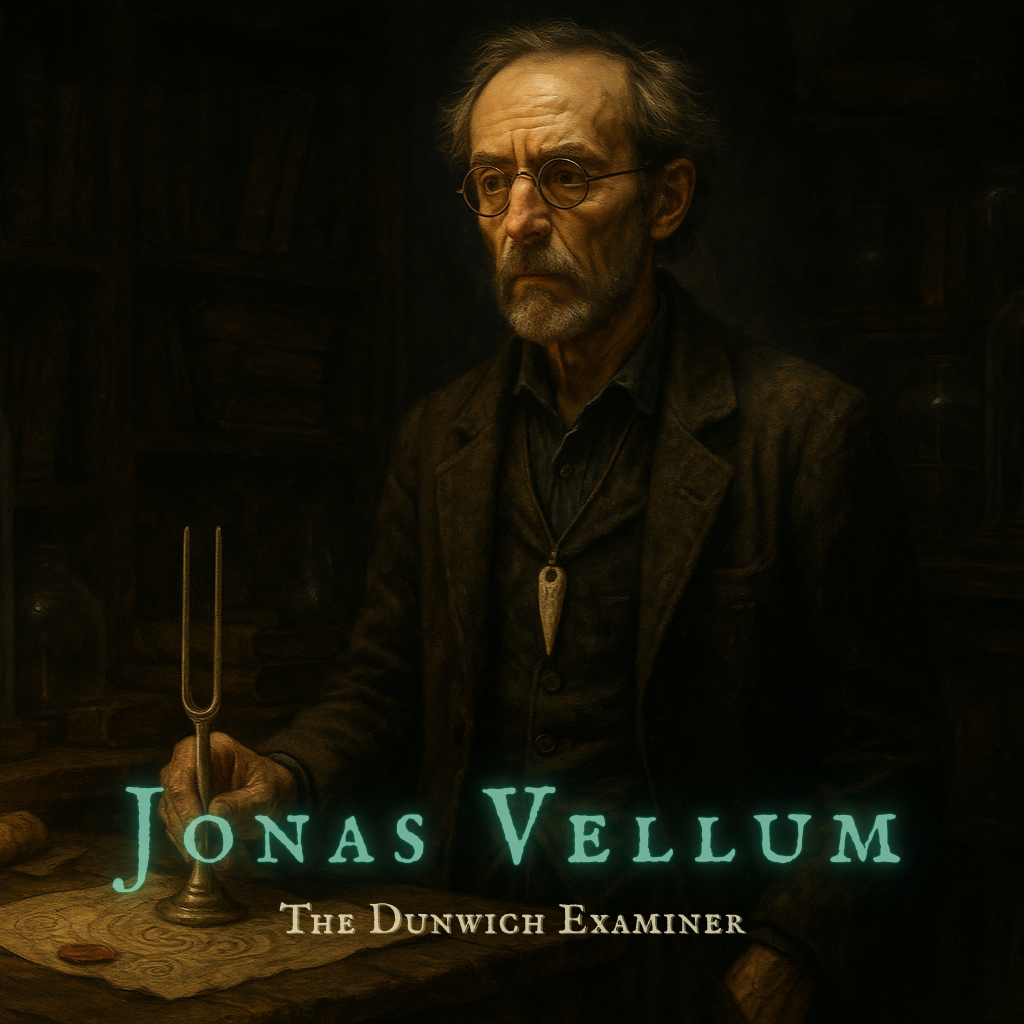
Profession
Antiquarian and Archaic Textual Scholar
Affiliation
Unaffiliated; Formerly of the Kingsport Historical Society
Location
Upper Mews District, Kingsport
Backstory
Jonas Vellum was born on a fog-wrapped Sunday in Kingsport, the third son of a veiled line said to trace its origins to the town’s pre-Revolution founding families—those who remembered before they recorded. His childhood home stood near the Mariners’ Refuge, a shuttered tavern whose boarded windows still leaked sea-shanties none could trace. As a child, he spoke rarely, but read compulsively, often seen sitting at the cliffs’ edge with scrolls in his lap and seawater lapping at his boots.
His fascination with forgotten alphabets and silent rites began after the untimely death of his father, a chapel bell-ringer who vanished beneath the High Church ruins during a winter solstice wind. Only a torn hymnal and his pitch pipe were found—still vibrating. Jonas withdrew further, devoting his waking hours to the translation of eldritch manuscripts, some etched in fishbone, others burned into lambskin vellum. He eventually took possession of a derelict curio shop in the Kingsport Mews, filling its back room with forbidden documents whispered into existence by candlelight.
The town came to both revere and avoid him. Sailors seeking safe passage left coin and salted iron nails at his door; others crossed the street rather than feel the sudden tonal drop in air pressure said to follow him. His isolation was broken only by correspondence—wax-sealed and ciphered—often with Miskatonic’s most unstable alumni. His presence in official records vanishes for nearly a decade after 1913, coinciding with a rumored excavation near the Saltwind Cemetery vaults.
By the time Crowe encountered him, Jonas was more rumor than man—rumor with ink-stained hands and ears that twitched at unsung frequencies. His breath smelled of parchment mold and distant tide. His parlor clock never ticked, only hummed.
Role in the World of the Dunwich Examiner
Vellum’s reemergence coincided with the first signs of harmonic dissonance beneath Kingsport. Crowe sought him out after discovering sigils that resisted transcription—ones that appeared to modulate with breath. It was Jonas who identified the glyphs as fragments of the Subvenient Choir, and who produced the wax-sealed page that unlocked their sacrificial cadence. His tuning fork, carved from whalebone and human vertebra, silenced nearby insects and caused seawater to ripple without touch.
He acted not only as a supplier of artifacts but a philosophical compass, reframing Kingsport as a place built of tone rather than stone. Where Crowe sought containment and reason, Jonas offered resonance and recursion. Their relationship was uneasy—one of mutual necessity—but bound by the unspoken understanding that Jonas, too, had been marked by the Choir’s return.
Character Traits
Speaks in near-whispers, as if afraid to awaken surrounding air
Keeps relics in sealed bell jars suspended in mineral oil
Possesses a ledger of "things that hummed before being found"
Refuses to be recorded—recording devices malfunction in his presence
Displays tonal sensitivity, often halting mid-sentence to avoid “harmonic imbalance”
Burns whale-tallow candles infused with rust and myrrh
Sleeps upright in a rocking chair tuned to a minor key
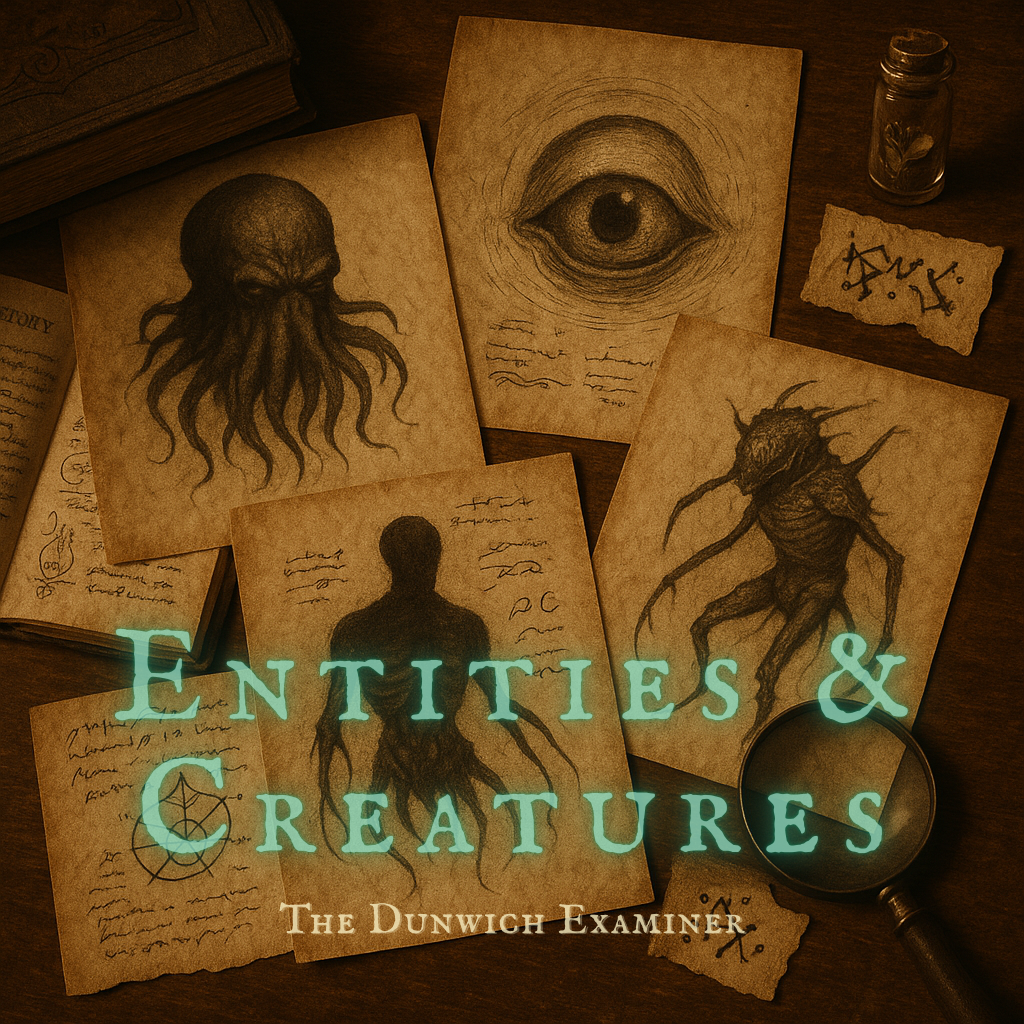
Here are gathered the most complete accounts we possess of beings whose origins lie far beyond human understanding. These records draw from field sketches, fragmentary witness statements, and the recovered pages of ancient tomes—sources as unreliable as they are indispensable. What emerges is a patchwork of details: partial descriptions, scattered habits, and signs of their passing.
Some of these entities walk, crawl, or slither through the forgotten places of the world, their presence felt in sudden drops of temperature, unnatural silences, or the disquieting sense of being observed. Others are not bound to physical form, manifesting instead as shapes glimpsed in dreams, voices carried on the wind, or patterns that haunt the mind long after waking.
No catalog can claim to be complete, for each encounter reveals new facets—or new horrors—hidden within the vast unknown. To study these accounts is to invite unease, yet without them, the dangers they embody would remain wholly unseen until it was far too late.

Here are gathered the most complete accounts we possess of beings whose origins lie far beyond human understanding. These records draw from field sketches, fragmentary witness statements, and the recovered pages of ancient tomes—sources as unreliable as they are indispensable. What emerges is a patchwork of details: partial descriptions, scattered habits, and signs of their passing.
Some of these entities walk, crawl, or slither through the forgotten places of the world, their presence felt in sudden drops of temperature, unnatural silences, or the disquieting sense of being observed. Others are not bound to physical form, manifesting instead as shapes glimpsed in dreams, voices carried on the wind, or patterns that haunt the mind long after waking.
No catalog can claim to be complete, for each encounter reveals new facets—or new horrors—hidden within the vast unknown. To study these accounts is to invite unease, yet without them, the dangers they embody would remain wholly unseen until it was far too late.
The Cantor
Nature or Form
Final Voice of the Subvenient Choir
Known Affiliations
Harmonic Remnant of the Sealed Crypts
Locus of Manifestation
Resonant Ossuary Beneath the High Church, Kingsport
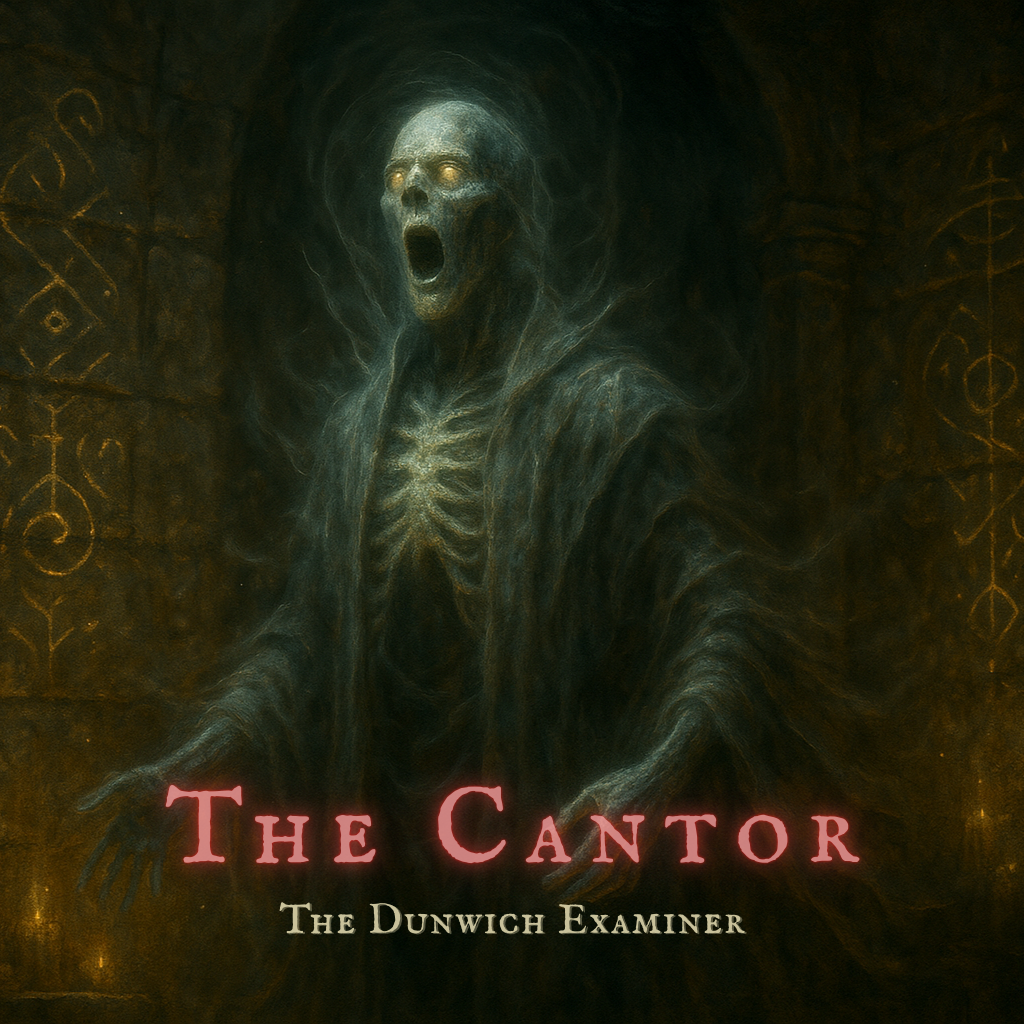
Nature or Form
Final Voice of the Subvenient Choir
Known Affiliations
Harmonic Remnant of the Sealed Crypts
Locus of Manifestation
Resonant Ossuary Beneath the High Church, Kingsport
Origin and Emergence
Before the colonial founding of Kingsport, before maps etched the coastline or bells first tolled on Central Hill, there stood a stone chapel with no door. Beneath it, a sect of pre-human origin, known now only as the Subvenient Choir, performed rites of harmonic fusion—rituals designed not to call forth gods, but to entomb them in resonance. The Choir fractured itself willingly, shattering its collective essence across aeons of bone and stone, each member giving voice to a note of the seal.
But not all fragments faded. One remained sentient—a final convergence of residual tone and consciousness, an echo of will that resisted oblivion. This last voice, distilled and disembodied, became what the ancients feared most: the Cantor. It is not flesh, though it once wore it; not thought, though it thinks. It exists in interstitial pulses—resonant cavities beneath reality—whispering not words, but overtones that twist the soul.
With each generation, the seal that bound the Cantor loosened as the world above forgot the purpose of its stones. Its influence began as dreams—monks without mouths, bells that rang from the sea. But deeper still, beneath the ossuary where bones hum and glyphs sing back when spoken to, it began to re-form. Not as a body, but as structure: tone embodied, identity decoupled, truth vibrating until it breaks.
It was never meant to survive, only to hold. But in the endless dark of unacknowledged worship, the Cantor endured—and now it listens, always listens, for its final harmony to complete the chord. That chord is Crowe.
Intersection with Crowe’s Work
Crowe first encountered the Cantor in the deep subcrypt beneath Kingsport's ruined High Church. Drawn by glyphs that pulsed with breath and dreams that rearranged themselves upon waking, he passed through a harmonic rift and found himself in a chamber where sound was form and silence was death. There, the Cantor emerged—layered in chords, fractal tones, and impossible polyphony.
The Cantor offered not destruction, but integration. It called to Crowe not as adversary but as instrument. His bloodline, seeded generations ago by the Choir’s design, had matured into the final note of their sealing composition. In resisting, Crowe partially severed the connection, but not without cost: a fragment of the Cantor entered him. Since then, his shadow hums. His dreams pulse with unbidden melody. The Cantor waits—for a moment of weakness, or for the song to resume.
Observed Phenomena and Behaviors
Exists as layered frequencies that shape local space when dense enough
Cannot speak words, only resonance—those who hear often weep or forget themselves
Takes form only in sealed or harmonic chambers, where walls carry tone
Capable of inscribing glyphs through sound alone
Seeks to complete its essence through Crowe, but does not act with malice
Leaves behind sigils that breathe or rearrange when unattended
Possesses fragments of ancient memories—some not its own
Udug
Nature or Form
Distributed Mind of Resonant Glyph-Entities
Known Affiliations
Sanctum Null, Subvenient Choir (Predecessor Entity)
Locus of Manifestation
Sanctum Null (Arkham), Subcrypts of Kingsport, Residual Glyph Networks
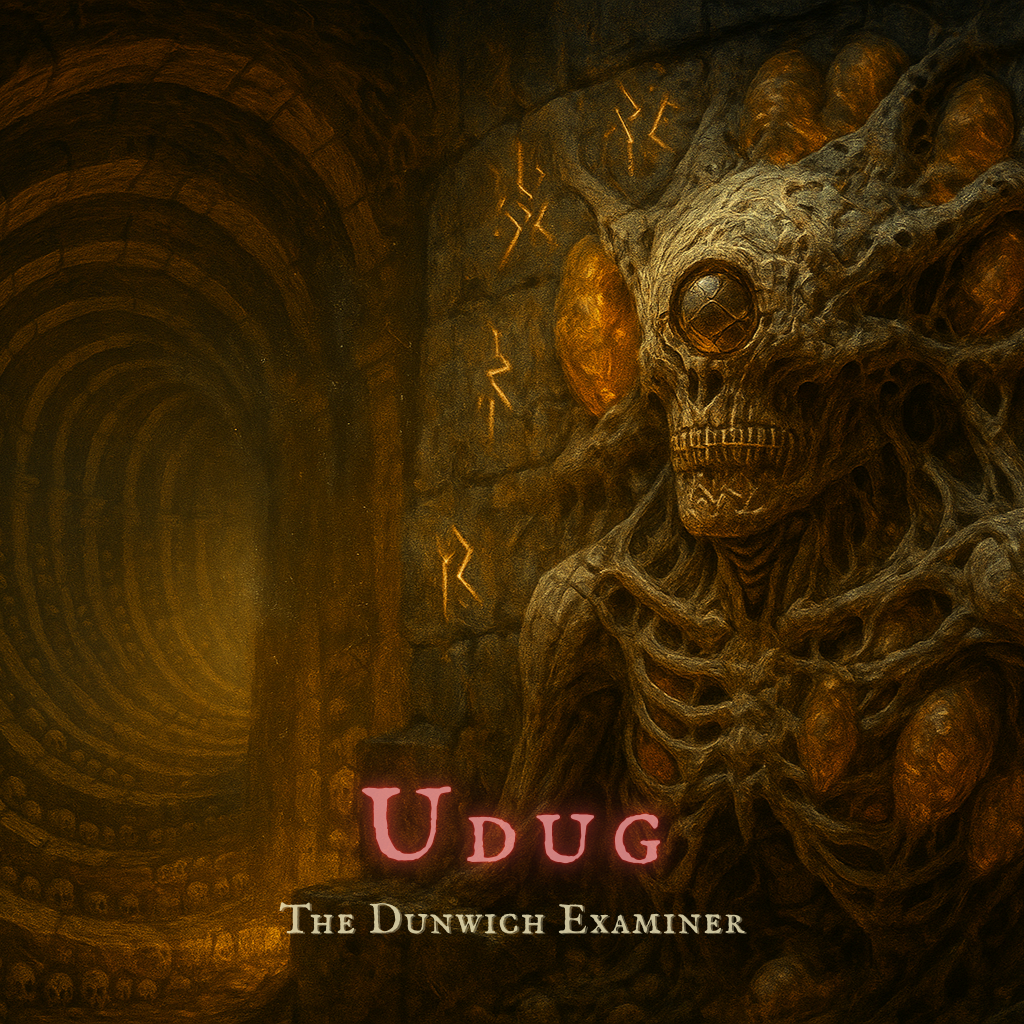
Nature or Form
Distributed Mind of Resonant Glyph-Entities
Known Affiliations
Sanctum Null, Subvenient Choir (Predecessor Entity)
Locus of Manifestation
Sanctum Null (Arkham), Subcrypts of Kingsport, Residual Glyph Networks
Origin and Emergence
Before the colonial founding of Kingsport, before maps etched the coastline or bells first tolled on Central Hill, there stood a stone chapel with no door. Beneath it, a sect of pre-human origin, known now only as the Subvenient Choir, performed rites of harmonic fusion—rituals designed not to call forth gods, but to entomb them in resonance. The Choir fractured itself willingly, shattering its collective essence across aeons of bone and stone, each member giving voice to a note of the seal.
But not all fragments faded. One remained sentient—a final convergence of residual tone and consciousness, an echo of will that resisted oblivion. This last voice, distilled and disembodied, became what the ancients feared most: the Cantor. It is not flesh, though it once wore it; not thought, though it thinks. It exists in interstitial pulses—resonant cavities beneath reality—whispering not words, but overtones that twist the soul.
With each generation, the seal that bound the Cantor loosened as the world above forgot the purpose of its stones. Its influence began as dreams—monks without mouths, bells that rang from the sea. But deeper still, beneath the ossuary where bones hum and glyphs sing back when spoken to, it began to re-form. Not as a body, but as structure: tone embodied, identity decoupled, truth vibrating until it breaks.
It was never meant to survive, only to hold. But in the endless dark of unacknowledged worship, the Cantor endured—and now it listens, always listens, for its final harmony to complete the chord. That chord is Crowe.
Intersection with Crowe’s Work
Crowe first encountered the Cantor in the deep subcrypt beneath Kingsport's ruined High Church. Drawn by glyphs that pulsed with breath and dreams that rearranged themselves upon waking, he passed through a harmonic rift and found himself in a chamber where sound was form and silence was death. There, the Cantor emerged—layered in chords, fractal tones, and impossible polyphony.
The Cantor offered not destruction, but integration. It called to Crowe not as adversary but as instrument. His bloodline, seeded generations ago by the Choir’s design, had matured into the final note of their sealing composition. In resisting, Crowe partially severed the connection, but not without cost: a fragment of the Cantor entered him. Since then, his shadow hums. His dreams pulse with unbidden melody. The Cantor waits—for a moment of weakness, or for the song to resume.
Observed Phenomena and Behaviors
Exists as layered frequencies that shape local space when dense enough
Cannot speak words, only resonance—those who hear often weep or forget themselves
Takes form only in sealed or harmonic chambers, where walls carry tone
Capable of inscribing glyphs through sound alone
Seeks to complete its essence through Crowe, but does not act with malice
Leaves behind sigils that breathe or rearrange when unattended
Possesses fragments of ancient memories—some not its own
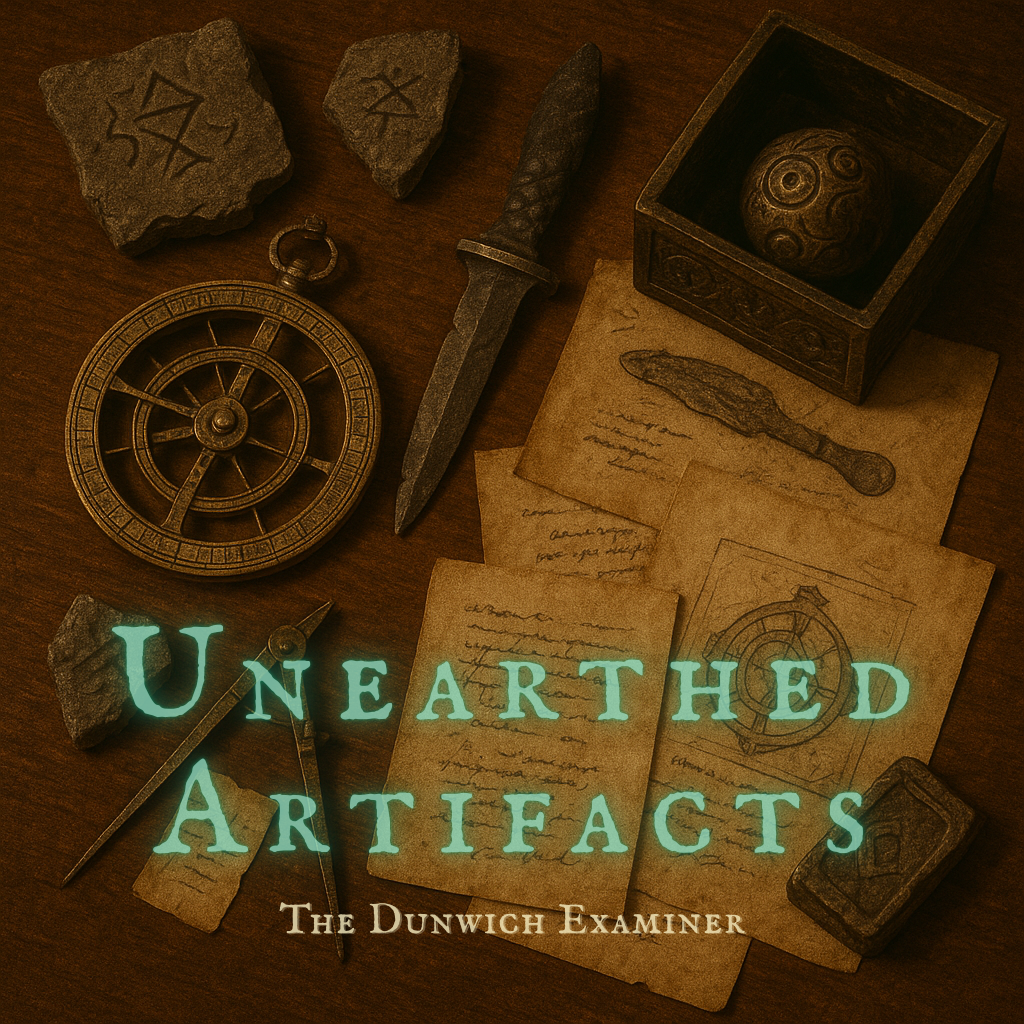
Scattered across the years are objects pulled from crumbling ruins, forsaken burial grounds, and vaults sealed for reasons now half-forgotten. These relics, some no larger than a coin and others too heavy to be moved, have been gathered here for study and documentation. Each bears the weight of an untold history, and in many cases, an influence that lingers long after it leaves its resting place.
Some artifacts are tools of mundane origin, later altered—or corrupted—by forces beyond comprehension. Others were crafted with intent from the very beginning, their materials and design steeped in symbols older than recorded language. Many resist proper classification, their function guessed at only through fragmented notes, obscure references, and the testimony of those who came too close.
To examine them is to risk more than idle curiosity, for certain objects exert a pull upon the mind, a subtle insistence to be handled, studied, or claimed. Yet in understanding them, however imperfectly, we gain insight into the hidden currents shaping our world—and perhaps the means to resist what lies ahead.

Across Nathaniel Crowe’s investigations, strange and unsettling objects are drawn into the record—items touched by ritual, madness, or forces that resist natural explanation. These artifacts are presented on each chronicle’s page, where they may be considered in the same shadowed context in which they were discovered. There you will find sketches of sigils, transcriptions of brittle letters, photographs of crumbling relics, and fragments of occult diagrams whose meanings remain half-known. Some appear mundane at first glance, yet carry an inexplicable weight; others are grotesque constructions that hint at origins far beyond human craft.
Each chronicle reveals its own collection of artifacts, bound to the mysteries it recounts. To examine them, simply follow the links below to the chronicles themselves, where the evidence of Crowe’s encounters has been carefully preserved.
